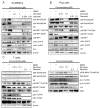Differential Targeting of Gr-MDSCs, T Cells and Prostate Cancer Cells by Dactolisib and Dasatinib
- PMID: 32230980
- PMCID: PMC7178187
- DOI: 10.3390/ijms21072337
Differential Targeting of Gr-MDSCs, T Cells and Prostate Cancer Cells by Dactolisib and Dasatinib
Abstract
Granulocytic myeloid-derived suppressor cells (Gr-MDSCs) promote immune evasion and resistance to immunotherapeutics in a variety of malignancies. Our previous study showed that dual PI3K/mTOR inhibitor Dactolisib impaired the viability and immunosuppressive function of Gr-MDSCs, and significantly synergized with immune checkpoint blockade (ICB) antibodies targeting PD1 and CTLA4 to eradicate metastatic castration-resistant prostate cancer (CRPC) in a preclinical transgenic mouse model. On the contrary, tyrosine kinase inhibitor Dasatinib diminished tumor-infiltrating T lymphocytes and showed no synergic activity with ICB. The understanding of the distinct effects of Dactolisib and Dasatinib on Gr-MDSCs, T cells and prostate neoplastic cells is inadequate, limiting the clinical translation of the combination immunotherapy. To address this question, we applied Reverse Phase Protein Array (RPPA) to profile 297 proteins and protein phosphorylation sites of Gr-MDSCs, T cells and prostate cancer cells isolated from the CRPC model. We found cell type-specific protein expression patterns and highly selective targets by the two drugs, including preferential inhibition of phospho-4E-BP1 in Gr-MDSCs by Dactolisib and preferential suppression of phospho-Src and phospho-p38 MAPK in T cells. Furthermore, transcriptomic profiling of Gr-MDSCs treated with the two inhibitors revealed downregulation of mitochondrial respiration pathways by Dactolisib but not Dasatinib. Overall, these results provide important mechanistic insight into the efficacious combination of Dactolisib and ICB as well as the detrimental effect of Dasatinib on anti-tumor immunity.
Keywords: Dactolisib; Dasatinib; PI3K/mTOR; Src; castration-resistant prostate cancer; combination immunotherapy; granulocytic myeloid-derived suppressor cells; immune checkpoint blockade; mitochondrial respiration; reverse phase protein array.
Conflict of interest statement
The authors declare no conflict of interest. The funders had no role in the design of the study; in the collection, analyses, or interpretation of data; in the writing of the manuscript, or in the decision to publish the results.
Figures





References
-
- Bronte V., Brandau S., Chen S.H., Colombo M.P., Frey A.B., Greten T.F., Mandruzzato S., Murray P.J., Ochoa A., Ostrand-Rosenberg S., et al. Recommendations for myeloid-derived suppressor cell nomenclature and characterization standards. Nat. Commun. 2016;7:12150. doi: 10.1038/ncomms12150. - DOI - PMC - PubMed
MeSH terms
Substances
Grants and funding
LinkOut - more resources
Full Text Sources
Medical
Molecular Biology Databases
Miscellaneous

